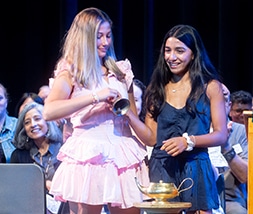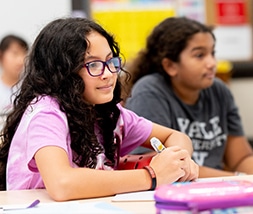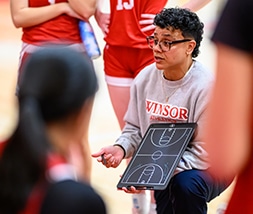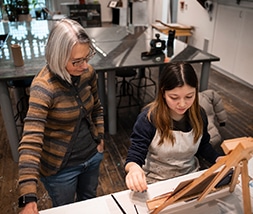Curriculum Guide
Lower School STEM Courses
Class I: Library and Technology Skills
In this course, students learn to access quality information for pleasure reading and research in both print books and digital sources using the online library catalog, subscription databases, and search engines. Students learn to ask probing research questions, assess sources for reliability and objectivity, and practice good scholarship by accurately paraphrasing information and citing sources using MLA format. The second semester is primarily devoted to each student completing a research project of their choosing. Students also explore digital citizenship and online safety.
Class II: Coding
In this hands-on course, students learn how to program a computer to create dynamic multimedia output using the Processing language (Java-based) and P5.js (Javascript-based). Students develop the skills of text-based syntax and gain experience with various data types, conditionals, functions, user inputs, graphics, physical computing, and more, while designing video games and other digital interactions.
Class III STEM Courses
Students in Class III take both of the courses described below, one each semester. Half of the Class III students will take Circuits and Electronics first, and the other half will take CAD for 2D and 3D Fabrication first.
Class III: Circuits, Components and Signals
In this course, students build on their knowledge of programming from Class II and develop a deeper understanding of electronics by learning to build and design circuits using a variety of components such as LEDs, servo motors, potentiometers, piezo buzzers, and proximity sensors, to name a few. Students prototype, test, and revise their circuits on breadboards. In addition, embedded coding is used to interface with their designs.
Class III: Computer Aided Design for 2D and 3D Fabrication
Using Computer Aided Design (CAD) software to render and fabricate precise geometries for mechanical parts and interesting forms, students will practice methods in 3D visualization, additive and subtractive manufacturing, rapid prototyping, measurement, and quality assessment. In the process, they will gain experience with tolerance, precision, and materials of varying characteristics through the lens of engineering design. 3D printers as well as laser cutters/engravers, operating in 2D, will be used regularly. Students will also learn about how these machines function, how they are maintained, how to design for their strengths, and how to test their designs as the basis for improvement.
Class IV STEM Studios
Class IV students have the choice of a design team where they will have the opportunity to apply the skills learned in their Classes I–III STEM classes to interdisciplinary engineering challenges. Teams are thematic in nature and follow a design-thinking or project-based learning model. All projects involve some coding, electronics, and 3D design, in a context chosen by the students. All students select one semester-long course from the list below. The other semester, students may elect to participate on another team or to have a study.
The Automation Lab
This course introduces students to robotics and prepares them for competition in the First Lego League. Robotics integrates programming, electronics, 3D design, and other prototyping skills in an applied setting, to create machines that function autonomously. Students in this course will develop habits of prototyping, engage in a design cycle, further their fabrication skills, establish methods of quality control, and participate in interdisciplinary problem solving. This is a semester course, where students will meet 1x a cycle during quarter 1 then meet 2x per cycle in Q2, and participate in a weekend competition toward the end of the semester.
Data Acquisition Team
Building devices to make real measurements, you could finally settle questions about who can make the most noise and which is the smelliest cheese, you could answer local environmental questions about the pollutants around us and nearby soil quality, you could begin scientific investigations into heart rate and electrical activity in muscles, or you could follow curiosity to allow us to hear what bats would sound like, if only we could hear ultrasonic frequencies. As a member of the Data Acquisition team, students will build and use scientific instruments, and then visualize data to illuminate the invisible and experience the hidden. Students will be introduced to “big data” and find agency through information. They will integrate programming, electronics, 3D design, and other STEM skills and apply them to the acquisition, processing, and application of data. Students will develop habits of prototyping, engage in a design cycle, further their fabrication skills, establish methods of quality control, and participate in interdisciplinary problem solving.
The Prototyping Lab
For anyone who ever wanted their umbrella to tell them when to bring it, their vacuum to check a calendar and operate itself, their fish to be fed by a mobile app, or for anyone who ever noticed that a lot of things could be better, the Prototyping House will rethink and redesign the commonplace to be smarter, more efficient, more interesting, and more capable. Students will integrate programming, electronics, 3D design, and other prototyping skills and apply them to tinker with the things around us and to fabricate original ideas. They will develop habits of prototyping, engage in a design cycle, further their fabrication skills, establish methods of quality control, and participate in interdisciplinary problem solving.
Manifest Arts STEAM Studio
Art has always had a relationship with technology. Painters needed canvas and sculptors needed chisels, and you have LEDs, servo motors, infrared sensors, 3D printers, computers, and so much more. In the Manifest Arts Studio, students will design physical objects that change or evolve over time and in relation to their environment. They will integrate programming, electronics, 3D design, and other prototyping skills and apply them to produce works of art with which we physically interact. Students will develop habits of prototyping, engage in a design cycle, further their fabrication skills, establish methods of quality control, and participate in interdisciplinary problem solving.
Temporal Arts STEAM Studio
Performing arts are experienced temporally, as a function of time, and they have also evolved over time, as technology defined the sound of each era’s music, advanced complex stage productions, and created film from static pictures. When we push technology forward, we can advance art itself. The Temporal Arts Studio will engineer equipment for creating works of sound and motion. Students will integrate programming, electronics, 3D design, and other prototyping skills and apply them to produce art that we experience through performance. They will develop habits of prototyping, engage in a design cycle, further their fabrication skills, establish methods of quality control, and participate in interdisciplinary problem solving.
Interaction Design Studio
Design is problem solving, but also much more. Designers make the art of our daily lives, they shape technology for human needs, they apply thought to rationally make decisions from the minutiae of fonts on an interface to the overarching architecture of a machine and beyond, and they bridge fields from engineering to art. Members of the Interaction Design Studio will exercise brainstorming techniques, utilize methods of rapid prototyping, conduct qualitative research, iterate, and put human interaction front and center. Students will explore solutions, looking beyond merely overcoming technical hurdles to make things that reflect the people they are made for. They will integrate programming, electronics, 3D/2D design, and other prototyping skills and apply them to design the products with which we interact.





